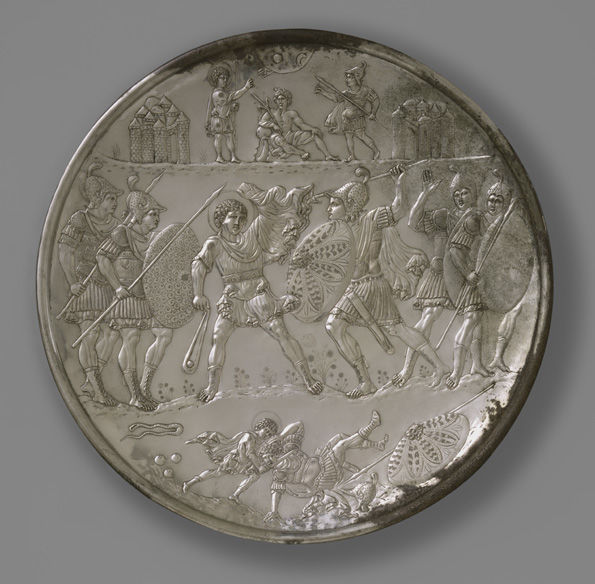Emperor Heraclius (ca. 575–641) came to power in 610 after instigating an overthrow of the reputedly tyrannical Emperor Phokas. Entering Constantinople, so the story goes, Heraclius captured Phocas and demanded: "Is this how you have ruled, wretch?" The belittled emperor replied, "And will you rule better?"
Heraclius proved his strength, if not his wit, by first removing Phocas's head, and then his genitalia.1 The first years of Heraclius's reign were characterized by a number of military campaigns against the Persians, who were threatening the eastern frontier of the empire, and the Slavs and Avars, who were invading the northern Balkans. A crucial turning point occurred in 626 when the Persian commander Shahrbaraz and the Avars unsuccessfully attacked Constantinople. Their retreat allowed Heraclius to take the offensive position, invade Persia, and extract a peace treaty. By 629 Heraclius had regained Egypt from Persian rule.
Although his military success was temporary—in 634 the Arabs invaded Syria and destroyed the Byzantines at Yarmuk—Heraclius's victories in Persia, where he recovered the True Cross, were remarkable. The splendid David Plates might have been created in his honor. The emphasis on David's valor evoked Heraclius's military successes. By representing the legitimacy of David's claim to succeed Saul, the plates also cast Heraclius as the "new David," supporting the authenticity of his position as emperor (even though he did not take the seat of authority in the most decorous way).2
Plate with the Battle of David and Goliath, 629–630. Made in Constantinople. Silver. The Metropolitan Museum of Art, New York, Gift of J. Pierpont Morgan, 1917 (17.190.396)
In addition to military campaigns, Heraclius also battled in the religious sphere, hoping to resolve the church's split over beliefs about the nature of Christ. With Sergios I, the patriarch of Constantinople (r. 610–38), and Kyros, the Chalcedonian archbishop of Alexandria (r. 631–42), Heraclius promoted Monoenergism—a view that defined the two natures of Christ operating through a single energy.3 This compromise position was not accepted, nor was the alternative position, Monotheletism—a view in which the two natures of Christ are united in a single will. The religious debates were not quelled under Heraclius, and they continued to divide believers into the reign of succeeding rulers.
Despite his inability to establish full religious or political unity, Heraclius was crucial to the character of the Byzantine empire. The wide geographical range represented by the coins from his reign demonstrate that he oversaw a level of prosperity throughout the empire. Meanwhile, the institution of Greek (instead of Latin) as the official language of the state indicates his central role in participating in, if not facilitating, massive cultural change.
[1] Olster 1991, 133; Charles 2007, 177.
[2] Alexander, 236; Evans, "Plates with Scenes from the Life of David," 17.
[3] Ratliff, 37.
Bibliography
Alexander, Suzanne Spain, "Heraclius, Byzantine Imperial Ideology, and the David Plates." Medieval Academy of America 52 (2): 217–237.
Charles, Robert Henry. The Chronicle of John, Bishop of Nikiu: Translated from Zotenberg's Ethiopic Text (2007 ed.). Arx Publishing.
Conrad, Lawrence. "Heraclius in Early Islamic Kerygma." The Reign of Heraclius (610 – 641 ): Crisis and Confrontation, edited by Gerrit J. Reinink and Bernard H. Stolte, 113–56. Leuven, 2002.
Evans, Helen C. "Byzantium and Islam: Age of Transition (7th–9th Century)." In Byzantium and Islam: Age of Transition, 7th–9th Century. Ed. Helen C. Evans. New Haven: Yale University Press, 2012. 4–11.
———"Heraclius." Byzantium and Islam: Age of Transition, 7th–9th Century. Ed. Helen C. Evans. New Haven: Yale University Press, 2012. 14–15.
———"Plates with Scenes from the Life of David." Byzantium and Islam: Age of Transition, 7th–9th Century. Ed. Helen C. Evans. New Haven: Yale University Press, 2012. 16–17.
Foss, Clive, "The Persians in Asia Minor and the End of Antiquity." The English Historical Review 90:
721–47.
Haldon, John. Byzantium in the Seventh Century: the Transformation of a Culture. Cambridge, 1990.
Kaegi, Walter E. Heraclius: Emperor of Byzantium. Cambridge, 2003.
Walter Emil Kaegi, Alexander Kazhdan, Anthony Cutler "Herakleios" The Oxford Dictionary of
Byzantium. Ed. Alexander P. Kazhdan. © 1991, 2005 by Oxford University Press, Inc.. The Oxford Dictionary of Byzantium: (e-reference edition). Oxford University Press. Yale University. 23 February 2012 http://www.oxford-byzantium.com/entry?entry=t174.e2258
Olster, David Michael. The Politics of Usurpation in the Seventh Century: Rhetoric and Revolution in
Byzantium (1993 ed.). A.M. Hakkert
Ratliff, Brandie. "Christian Communities during the Early Islamic Centuries." Byzantium and Islam: Age of Transition, 7th-9th Century. Ed. Helen C. Evans. New Haven: Yale University Press, 2012. 32–39.
